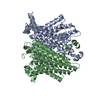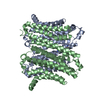+ Open data
Open data
- Basic information
Basic information
| Entry | Database: PDB / ID: 8vic | |||||||||||||||||||||
|---|---|---|---|---|---|---|---|---|---|---|---|---|---|---|---|---|---|---|---|---|---|---|
| Title | AP-6 bound human TMEM175 | |||||||||||||||||||||
 Components Components | Endosomal/lysosomal potassium channel TMEM175 | |||||||||||||||||||||
 Keywords Keywords | TRANSPORT PROTEIN / Ion Channel / Lysosome / Potassium Channel | |||||||||||||||||||||
| Function / homology |  Function and homology information Function and homology informationlysosomal lumen pH elevation / phagosome-lysosome fusion / regulation of lysosomal lumen pH / potassium ion leak channel activity / proton channel activity / arachidonate binding / potassium channel activity / potassium ion transmembrane transport / proton transmembrane transport / neuron cellular homeostasis ...lysosomal lumen pH elevation / phagosome-lysosome fusion / regulation of lysosomal lumen pH / potassium ion leak channel activity / proton channel activity / arachidonate binding / potassium channel activity / potassium ion transmembrane transport / proton transmembrane transport / neuron cellular homeostasis / lysosome / endosome / endosome membrane / lysosomal membrane Similarity search - Function | |||||||||||||||||||||
| Biological species |  Homo sapiens (human) Homo sapiens (human) | |||||||||||||||||||||
| Method | ELECTRON MICROSCOPY / single particle reconstruction / cryo EM / Resolution: 3.48 Å | |||||||||||||||||||||
 Authors Authors | Oh, S. / Hite, R.K. | |||||||||||||||||||||
| Funding support |  United States, 1items United States, 1items
| |||||||||||||||||||||
 Citation Citation |  Journal: J Am Chem Soc / Year: 2024 Journal: J Am Chem Soc / Year: 2024Title: Discovery of Selective Inhibitors for the Lysosomal Parkinson's Disease Channel TMEM175. Authors: SeCheol Oh / Jooyeon Lee / Ho Jeong Choi / Songwon Kim / Vinay Sapuru / Min Kim / Richard K Hite /   Abstract: TMEM175 is a lysosomal potassium and proton channel that is associated with the development of Parkinson's disease. Advances in understanding the physiological roles of TMEM175 have been hampered by ...TMEM175 is a lysosomal potassium and proton channel that is associated with the development of Parkinson's disease. Advances in understanding the physiological roles of TMEM175 have been hampered by the absence of selective inhibitors, and studies involving genetic perturbations have yielded conflicting results. Here, we report the discovery and characterization of the first reported TMEM175-selective inhibitors, 2-phenylpyridin-4-ylamine (2-PPA), and AP-6. Cryo-EM structures of human TMEM175 bound by 2-PPA and AP-6 reveal that they act as pore blockers, binding at distinct sites in the pore and occluding the ion permeation pathway. Acute inhibition of TMEM175 by 2-PPA or AP-6 increases the level of lysosomal macromolecule catabolism, thereby accelerating macropinocytosis and other digestive processes. These inhibitors may serve as valuable tools to study the roles of TMEM175 in regulating lysosomal function and provide useful templates for future therapeutic development in Parkinson's disease. | |||||||||||||||||||||
| History |
|
- Structure visualization
Structure visualization
| Structure viewer | Molecule:  Molmil Molmil Jmol/JSmol Jmol/JSmol |
|---|
- Downloads & links
Downloads & links
- Download
Download
| PDBx/mmCIF format |  8vic.cif.gz 8vic.cif.gz | 244.6 KB | Display |  PDBx/mmCIF format PDBx/mmCIF format |
|---|---|---|---|---|
| PDB format |  pdb8vic.ent.gz pdb8vic.ent.gz | Display |  PDB format PDB format | |
| PDBx/mmJSON format |  8vic.json.gz 8vic.json.gz | Tree view |  PDBx/mmJSON format PDBx/mmJSON format | |
| Others |  Other downloads Other downloads |
-Validation report
| Summary document |  8vic_validation.pdf.gz 8vic_validation.pdf.gz | 1.2 MB | Display |  wwPDB validaton report wwPDB validaton report |
|---|---|---|---|---|
| Full document |  8vic_full_validation.pdf.gz 8vic_full_validation.pdf.gz | 1.2 MB | Display | |
| Data in XML |  8vic_validation.xml.gz 8vic_validation.xml.gz | 33.9 KB | Display | |
| Data in CIF |  8vic_validation.cif.gz 8vic_validation.cif.gz | 47.8 KB | Display | |
| Arichive directory |  https://data.pdbj.org/pub/pdb/validation_reports/vi/8vic https://data.pdbj.org/pub/pdb/validation_reports/vi/8vic ftp://data.pdbj.org/pub/pdb/validation_reports/vi/8vic ftp://data.pdbj.org/pub/pdb/validation_reports/vi/8vic | HTTPS FTP |
-Related structure data
| Related structure data |  43257MC  8vieC M: map data used to model this data C: citing same article ( |
|---|---|
| Similar structure data | Similarity search - Function & homology  F&H Search F&H Search |
- Links
Links
- Assembly
Assembly
| Deposited unit | 
|
|---|---|
| 1 |
|
- Components
Components
| #1: Protein | Mass: 55667.219 Da / Num. of mol.: 2 Source method: isolated from a genetically manipulated source Source: (gene. exp.)  Homo sapiens (human) / Gene: TMEM175 / Cell line (production host): HEK293S GnTI- / Production host: Homo sapiens (human) / Gene: TMEM175 / Cell line (production host): HEK293S GnTI- / Production host:  Homo sapiens (human) / References: UniProt: Q9BSA9 Homo sapiens (human) / References: UniProt: Q9BSA9#2: Chemical | ChemComp-A1AA3 / ( | Mass: 262.309 Da / Num. of mol.: 1 / Source method: obtained synthetically / Formula: C16H14N4 / Feature type: SUBJECT OF INVESTIGATION Has ligand of interest | Y | Has protein modification | N | |
|---|
-Experimental details
-Experiment
| Experiment | Method: ELECTRON MICROSCOPY |
|---|---|
| EM experiment | Aggregation state: PARTICLE / 3D reconstruction method: single particle reconstruction |
- Sample preparation
Sample preparation
| Component | Name: human TMEM175 in an inhibitor-bound state / Type: COMPLEX / Details: AP-6 bound TMEM175 / Entity ID: #1 / Source: RECOMBINANT | |||||||||||||||||||||||||
|---|---|---|---|---|---|---|---|---|---|---|---|---|---|---|---|---|---|---|---|---|---|---|---|---|---|---|
| Molecular weight | Value: 55 kDa/nm / Experimental value: NO | |||||||||||||||||||||||||
| Source (natural) | Organism:  Homo sapiens (human) Homo sapiens (human) | |||||||||||||||||||||||||
| Source (recombinant) | Organism:  Homo sapiens (human) Homo sapiens (human) | |||||||||||||||||||||||||
| Buffer solution | pH: 8 | |||||||||||||||||||||||||
| Buffer component |
| |||||||||||||||||||||||||
| Specimen | Conc.: 4 mg/ml / Embedding applied: NO / Shadowing applied: NO / Staining applied: NO / Vitrification applied: YES / Details: Dimeric channels | |||||||||||||||||||||||||
| Specimen support | Grid type: Quantifoil R1.2/1.3 | |||||||||||||||||||||||||
| Vitrification | Instrument: FEI VITROBOT MARK IV / Cryogen name: ETHANE / Humidity: 100 % / Chamber temperature: 298 K / Details: Blot for 4 seconds prior to plunging |
- Electron microscopy imaging
Electron microscopy imaging
| Experimental equipment |  Model: Titan Krios / Image courtesy: FEI Company |
|---|---|
| Microscopy | Model: FEI TITAN KRIOS |
| Electron gun | Electron source:  FIELD EMISSION GUN / Accelerating voltage: 300 kV / Illumination mode: FLOOD BEAM FIELD EMISSION GUN / Accelerating voltage: 300 kV / Illumination mode: FLOOD BEAM |
| Electron lens | Mode: BRIGHT FIELD / Nominal defocus max: 2000 nm / Nominal defocus min: 800 nm / Cs: 2.7 mm / C2 aperture diameter: 100 µm |
| Image recording | Average exposure time: 3 sec. / Electron dose: 66 e/Å2 / Detector mode: SUPER-RESOLUTION / Film or detector model: GATAN K3 (6k x 4k) / Num. of grids imaged: 2 |
| Image scans | Movie frames/image: 40 / Used frames/image: 1-40 |
- Processing
Processing
| EM software |
| ||||||||||||||||||||||||||||||||||||||||
|---|---|---|---|---|---|---|---|---|---|---|---|---|---|---|---|---|---|---|---|---|---|---|---|---|---|---|---|---|---|---|---|---|---|---|---|---|---|---|---|---|---|
| CTF correction | Type: PHASE FLIPPING AND AMPLITUDE CORRECTION | ||||||||||||||||||||||||||||||||||||||||
| Particle selection | Num. of particles selected: 3220435 | ||||||||||||||||||||||||||||||||||||||||
| 3D reconstruction | Resolution: 3.48 Å / Resolution method: FSC 0.143 CUT-OFF / Num. of particles: 215519 / Symmetry type: POINT | ||||||||||||||||||||||||||||||||||||||||
| Atomic model building | Protocol: OTHER / Space: REAL / Target criteria: FSC | ||||||||||||||||||||||||||||||||||||||||
| Refine LS restraints |
|
 Movie
Movie Controller
Controller




 PDBj
PDBj
